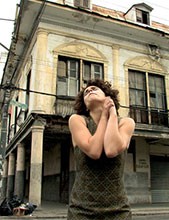Notice of Online Archive
This page is no longer being updated and remains online for informational and historical purposes only. The information is accurate as of the last page update.
For questions about page contents, contact the Communications Division.

A still of the video “Antojo (Desire)” by Karina Aguilera Skvirsky, assistant professor of art
Past-Imperfect is an exhibition of 10 video artworks from contemporary artists from Ecuador. The exhibit will run through March 5 in the Williams Visual Arts Building’s Grossman Gallery.
The videos play upon the philosophical concept of eterno retorno (eternal recurrence)—the infinite repetition of situations, events, thoughts, feelings, and ideas. In literal ways or in evocative metaphors the works reflect upon a set of socio-cultural experiences that weigh heavily upon the people of Ecuador.
A reception will be held 6 p.m. Feb. 15 in the gallery with a poetry performance by Karina Aguilera Skvirsky, assistant professor of art, at 7 p.m. Skvirsky’s video, “Antojo (Desire)” is part of the exhibition. Guest curator Rodolfo Kronfle Chambers will present an exhibition talk at noon Feb. 16 in the Gendebien Room of Skillman Library.
“The video Antojo (Desire) is a series of public recitations of a poem my mother taught me to perform when I lived in Guayaquil at age 10,” notes Skvirsky. “Afro-Ecuadorean poet Adalberto Ortiz used vernacular language from the oral art tradition of Esmeraldas, an area in Ecuador originally settled by escaped African slaves, to tell a cautionary tale about the dangers of miscegenation. ‘If you get with a white man/Your children are almost Black/Your children are almost white/Your children are nothing.’
“By re-enacting my childhood performances in front of panoramas of contemporary Guayaquil—its redeveloped waterfront, its slums, the decaying remnants of its grand architecture, and the kitschy celebration of its colonial past at Parque Historico (the Historical Park)—I examine the racial stereotypes of the poem while embracing its authenticity as a part of Afro-Ecuadorean identity.”
